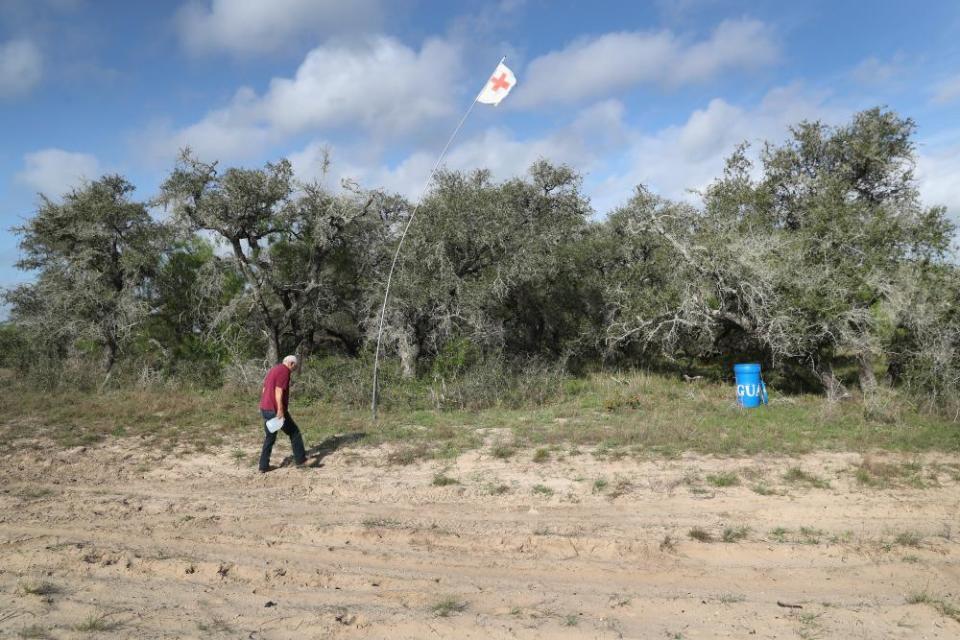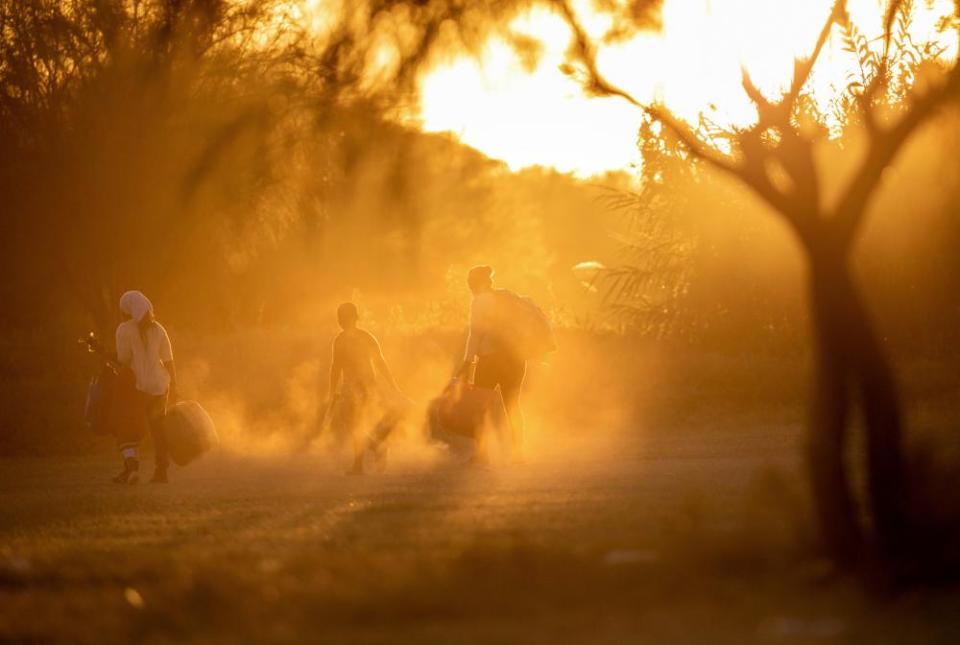The other Death Valley: hundreds of migrants are dying in remote Texas deserts
Eddie Canales can’t forget the moment he saw the decomposed body of a young man in his 20s hanging from an oak tree on a south Texas ranch last September.
The intense heat and humidity in this arid scrubland had quickly rotted his flesh to expose much of the skeleton, which had been at the scene for at least a week.
Clearly visible in a graphic image the sheriff’s office provided to the Guardian was the skull, lolling to one side. And both his feet are missing, probably eaten by wild animals.
The man was from Mexico, according to ID documents found. Police explored the possibility it was a lynching, but concluded it was suicide.
“Most of the bodies I encounter are already skeletonised,” said Canales, who runs the South Texas Human Rights Center, a non-profit based in Brooks county, Texas, working to put an end to the avoidable, harsh deaths, and reunite families with the remains of loved ones.

“But this was particularly harrowing. That image will stay with me forever,” he added.
Brooks county covers almost 1,000 square miles of sparse, brush-covered, sandy ranch lands not far from the eastern end of the US-Mexico border and is at the heart of a deadly migration crisis that is seeing desperate people die in record numbers.
So high is the grim toll that the surrounding region, spanning several Texas counties near the Rio Grande, has been called the other Death Valley.
Data bears out that terrible nickname: the Missing Migrants Project, an initiative by the Swiss-based International Organization for Migration (IOM) that tracks migrant deaths and disappearances globally, recorded 715 deaths of people trying to cross the US border from Mexico in 2021 – more than double the figure in 2015, making it the deadliest land crossing in the world.
Of the four US states along the border, Texas has the longest stretch and the highest number of migrant deaths, according to a report by the University of Texas’s Strauss Center. Brooks county, where authorities recovered 119 bodies last year, has had more deaths than any other Texas county over the last three decades.
“We’re struggling to deal with all the bodies,” said Don White, county deputy sheriff. Last year the county was provided with a mobile morgue by the state in response to the grisly human reaping. “I recently had to pick up three fresh ones in a day,” he said.
Outside experts believe that federal immigration policies have exacerbated the tragedy, forcing migrants into ever-more perilous crossings, and leading refugee journeys – fleeing violence, persecution and climate disaster – to an anguished dead end.
Eva Moya, an associate professor at the University of Texas studying the precarity faced by migrants, says the Migrant Protection Protocols (MPP), also known as “Remain in Mexico” – a policy introduced in 2019 under the Trump administration – has resulted in more than 70,000 people being sent back into Mexico to wait for their US court cases, often for extended periods in makeshift camps, where they are often denied basic health care and face violence, rape, murder and kidnappings by organised crime groups.
“The risk continues to increase,” says Moya. “Asylum seekers in Mexico are fearing for their lives and smugglers are taking advantage of that. They will do anything to make profit from these people. It’s human trafficking at its max.”
The Biden administration is finally ending the policy, after court battles, but it’s unclear how and when things will change substantially on the ground.
At the same time, Title 42, ostensibly a pandemic-related health measure introduced in 2020, closing border ports of entry and allowing Border Patrol to summarily expel migrants without asylum hearings, has exacerbated the deaths in Brooks county and beyond, said Alma Maquitico, director of the National Network for Immigrant and Refugee Rights.
“Title 42 has led to a rise in deaths,” she said. “People aren’t crossing at cities any more, but in more faraway, dangerous areas. They are dying in the desert.”

Canales also pointed to the rural, arid expanse.
“This is the real Death Valley,” he said, contrasting it with its scorching desert namesake in California.
“The immigration system has failed. The government wants to blame the cartel but not the policy that is creating this problem. The solution is to offer an ordered asylum pathway. You could fix this tomorrow,” he added.
A spokesperson for US Customs and Border Protection (CBP), which oversees the Border Patrol’s 20,000 agents working between the land ports of entry, said the death toll was the fault of traffickers.
“Criminal organisations continue to recklessly endanger the lives of individuals they smuggle for their own financial gain with no regard for human life,” they said in a statement. “Despite these inherent dangers, smugglers continue to lie to migrants, claiming the borders are open. The borders are not open, and people should not attempt to make the dangerous journey.”
Although Brooks county is about 70 miles from the US-Mexico border, it has the largest border patrol checkpoint in Texas. Located along US Highway 281, one of the few northbound highways along the hundreds of miles- long south Texas border region, Border Patrol processes an average 10,000 vehicles – traversing the busiest route from Mexico and Central America to the US – each day.
Like other deterrence policies, the checkpoint, instead of reducing the number migrants trying to enter, has driven them into deadly routes, according to deputy sheriff Don White.
People smugglers, often known as coyotes, demand thousands of dollars to help migrants cross the Rio Grande on rafts, usually to McAllen, Texas, where they will hide in dirty, cramped safe houses.
Migrants will then be dropped off 50 miles north on sandy backroads, before being sent on a days-long trek across brutal terrain, where temperatures regularly exceed 100F during the ever-hotter Texas summers and drop below freezing in winter, in order to avoid the checkpoint.
According to Oscar Carrillo, a sheriff in Culberson county, which is also dealing with a surge in bodies, smugglers often send groups of migrants in camouflage gear as well as with backpacks of cannabis, allowing them to reduce the fees owed by delivering the contraband to a contact, if they survive the journey.
In February 2020, Carrillo apprehended a group of more than 50 people en route. “They are given an itinerary like a cruise line,” says Carrillo. “There’s been a huge rise in attempts to cross. But it’s a dangerous place – there are snakes, mountain lions. If they can’t continue, they’ll be left behind.”
For those who make it over the first hurdles in an attempt to reach densely populated cities such as Houston, Dallas, and San Antonio, where they can live under the radar of the authorities, the risk is far from over.
In June, 53 immigrants, mostly from Mexico, were found dead inside a sweltering tractor-trailer on the outskirts of San Antonio, Texas, in what was the nation’s deadliest smuggling incident along the US-Mexico border to date.
Since 1999, more than 7,500 migrants from Mexico, El Salvador, Honduras, Guatemala and beyond are estimated to have died on the US-Mexico border, according to data from the CBP.
Most of these deaths can be attributed to heatstroke or dehydration, according to Canales, who maintains 90 water stations out in the brush.
Yet the real number of deaths is probably far higher, he said, due to limited data and a lack of support from federal authorities.
Since 95% of land on the southern border of Texas – and 99% in Brooks county – is private, ranchers and farmers on the remote plots – some as large as 50,000 acres – are often the ones that discover the recently or long-deceased people. Brooks county sheriff’s office estimates it finds only one out of every five bodies.
“It’s a burden that falls on volunteers,” said Canales. “It’s usually us who have to deal with the bodies.”
Yet Canales and his team of volunteers can only achieve so much. Analysis by the Center for Public Integrity found that more than 2,000 of the bodies of migrants recovered in the US have not been identified. The National Institute of Justice has called the ongoing tragedy of missing persons, which leaves families unable to properly mourn, the “nation’s silent mass disaster”.
Jonathan Alberto Callejas Corado, then 25, disappeared in June 2021 when he was attempting to cross from Mexico through Brooks county. The Guatemalan planned to join his aunt and uncle in Los Angeles, but he has been missing ever since.
“We don’t know if he’s alive or dead,” Glenda Corado, his aunt, told the Guardian. “It’s very painful for us. We can’t mourn because we don’t know what happened.”
In an attempt to find her lost nephew, last heard from in this remote corner of the nation that has become an open-air cemetery, she has visited the Guatemalan consulate, human rights organisations and even the headquarters of Border Patrol.
“We’ve been given no support,” says Corado. “The system is broken. What has happened to our boy?”

 Yahoo Movies
Yahoo Movies 
